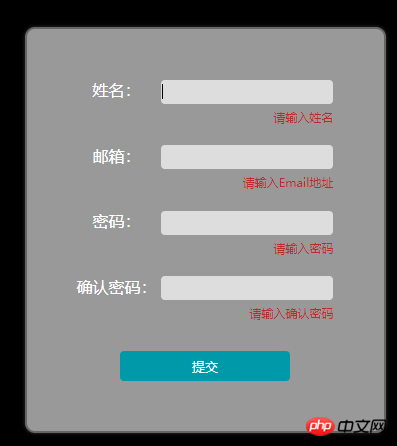Heim >Web-Frontend >js-Tutorial >So verwenden Sie das Formularvalidierungs-Plug-in „validate.js' von jQuery (Codebeispiel)
So verwenden Sie das Formularvalidierungs-Plug-in „validate.js' von jQuery (Codebeispiel)
- 青灯夜游nach vorne
- 2018-10-23 17:57:092172Durchsuche
Der Inhalt dieses Artikels besteht darin, die Verwendung des jQuery-Formularvalidierungs-Plug-ins „validate.js“ vorzustellen (Codebeispiel). Es hat einen gewissen Referenzwert. Freunde in Not können sich darauf beziehen. Ich hoffe, es wird Ihnen hilfreich sein.
Wirkung:

Code:
<!DOCTYPE html>
<html lang="en">
<head>
<meta charset="UTF-8">
<meta name="viewport" content="width=device-width, initial-scale=1.0">
<meta http-equiv="X-UA-Compatible" content="ie=edge">
<title>表单验证插件Validate</title>
<script src="js/jquery-1.10.2.min.js"></script>
<script src="js/jquery.validate.min.js"></script>
<style>
body {
background-color: #000;
}
form {
width: 361px;
margin: 80px auto;
padding: 50px;
border: 2px solid #666;
box-shadow: 0 0 5px rgba(255, 255, 255, 0.2);
background-color: #999;
border-radius: 10px;
box-sizing: border-box;
}
form>p {
margin-bottom: 20px;
color: #fff;
}
form>p>label {
display: inline-block;
width: 80px;
text-align: center;
}
label.error {
display: block;
width: 100%;
color: rgb(189, 42, 42);
font-size: 12px;
text-align: right;
margin-top: 5px;
}
input {
width: 170px;
height: 20px;
outline: none;
background-color: #ddd;
border: 1px solid #ddd;
border-radius: 4px;
}
.submit {
width: 170px;
margin: 30px auto 0;
}
.submit input {
background-color: #0099aa;
color: #fff;
border: 0;
padding: 5px;
height: 30px;
}
</style>
</head>
<body>
<form id="signupForm" action="" method="post">
<p>
<label for="name">姓名:</label>
<input type="text" id="name" name="name">
</p>
<p>
<label for="email">邮箱:</label>
<input type="email" id="email" name="email">
</p>
<p>
<label for="password">密码:</label>
<input type="password" id="password" name="password">
</p>
<p>
<label for="confirm_password">确认密码:</label>
<input type="password" id="confirm_password" name="confirm_password">
</p>
<p class="submit">
<input type="submit" value="提交">
</p>
</form>
</body>
<script>
$(function() {
$("#signupForm").validate({
rules: {
name: "required",
email: {
required: true,
email: true
},
password: {
required: true,
minlength: 5
},
confirm_password: {
required: true,
minlength: 5,
equalTo: "#password"
}
},
messages: {
name: "请输入姓名",
email: {
required: "请输入Email地址",
email: "请输入正确的Email地址"
},
password: {
required: "请输入密码",
minlength: "密码不能小于5个字符"
},
confirm_password: {
required: "请输入确认密码",
minlength: "确认密码不能小于5个字符",
equalTo: "两次输入的密码不一致"
}
}
});
})
</script>
</html>Das obige ist der detaillierte Inhalt vonSo verwenden Sie das Formularvalidierungs-Plug-in „validate.js' von jQuery (Codebeispiel). Für weitere Informationen folgen Sie bitte anderen verwandten Artikeln auf der PHP chinesischen Website!
Stellungnahme:
Dieser Artikel ist reproduziert unter:cnblogs.com. Bei Verstößen wenden Sie sich bitte an admin@php.cn löschen
Vorheriger Artikel:Fassen Sie die Methode zur Verwendung der WeChat-Zahlung für öffentliche Konten im Vue-Projekt zusammenNächster Artikel:Fassen Sie die Methode zur Verwendung der WeChat-Zahlung für öffentliche Konten im Vue-Projekt zusammen
In Verbindung stehende Artikel
Mehr sehen- Eine eingehende Analyse der Bootstrap-Listengruppenkomponente
- Detaillierte Erläuterung des JavaScript-Funktions-Curryings
- Vollständiges Beispiel für die Generierung von JS-Passwörtern und die Erkennung der Stärke (mit Download des Demo-Quellcodes)
- Angularjs integriert WeChat UI (weui)
- Wie man mit JavaScript schnell zwischen traditionellem Chinesisch und vereinfachtem Chinesisch wechselt und wie Websites den Wechsel zwischen vereinfachtem und traditionellem Chinesisch unterstützen – Javascript-Kenntnisse

